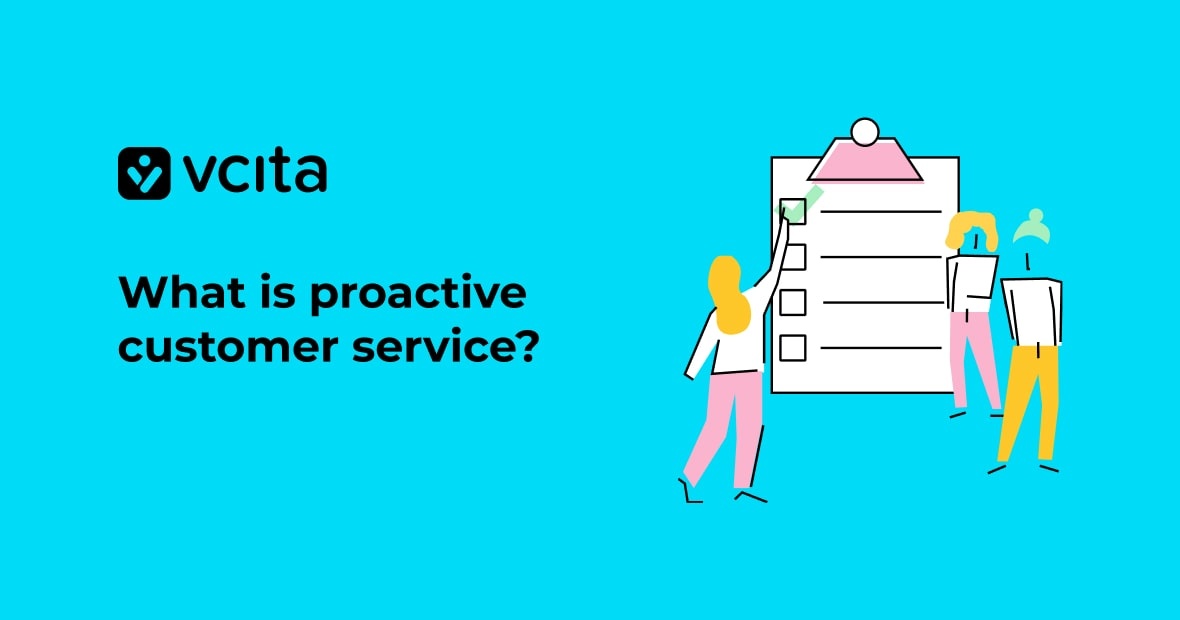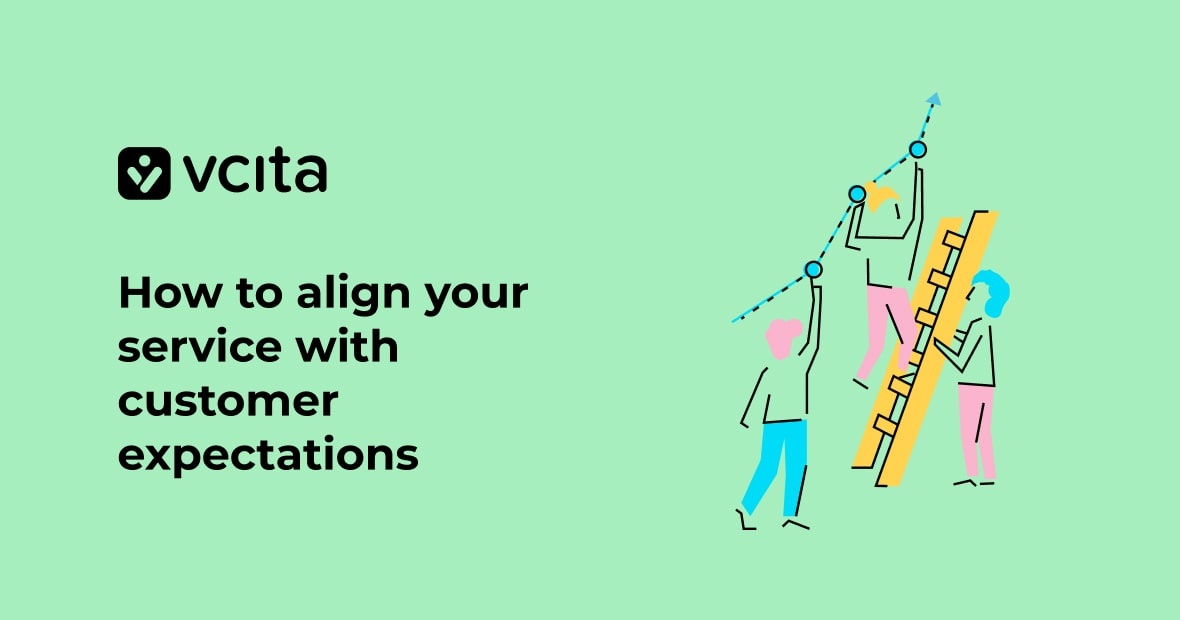Are you tired of playing catch-up with customer queries? If so, it’s time to ditch that reactive customer service mindset and embrace a proactive approach to customer support. By anticipating customers’ needs before they even ask, you’ll not only increase customer loyalty but also boost your bottom line.
In this article, we’ll dive into the game-changing world of proactive customer service strategies, from building a killer knowledge base to leveraging social media for customer experiences.
What is proactive customer service?
Proactive customer service is all about staying one step ahead of your customers’ needs. Instead of waiting for problems to arise, you’re anticipating and addressing them before they even occur. It’s like being a mind reader, but for customer satisfaction.
The shift from reactive to proactive
Traditional customer service often takes a reactive approach. That means that you wait for customers to reach out with issues, and then scramble to resolve them. But proactive customer service flips this model on its head. You’re not just putting out fires; you’re preventing them from starting in the first place.
Think about it: wouldn’t you rather prevent a customer’s frustration than try to smooth things over after the fact? That’s the essence of proactive customer support.
Key elements of a proactive approach
To truly embrace proactive customer service, you’ll want to focus on:
- Anticipating customer needs based on data and past experiences
- Regularly updating your knowledge base to address common issues
- Reaching out to customers with helpful information or product recommendations
- Using social media to engage with your customer base proactively
- Empowering your support team to identify and solve potential problems
The benefits of a proactive approach to customer service
Improved customer satisfaction
When you adopt a proactive customer service approach, you’re not just reacting to problems – you’re anticipating them. This shift from reactive customer service to a proactive strategy can dramatically improve customer experiences. By staying one step ahead, you can address potential issues before they even arise, leading to smoother interactions and happier customers.
Think about it: wouldn’t you prefer a company that solves problems before you even realize they exist? That’s the power of proactive customer support. It shows that you value your customers’ time and are committed to providing the best possible service.
Increased customer loyalty
Proactive customer service isn’t just about preventing problems – it’s about creating positive experiences. When you reach out to customers with helpful information, product recommendations, or just to check in, you’re building stronger relationships. This personal touch can significantly increase customer loyalty and turn casual buyers into devoted fans of your brand.
Remember, satisfied customers are more likely to become repeat customers. By consistently exceeding expectations, you’re not just solving issues – you’re creating advocates for your business. These loyal customers can become your most valuable asset, spreading positive word-of-mouth and helping to grow your customer base.
Reduced customer support workload
One of the most tangible benefits of a proactive customer service approach is the reduction in customer complaints. By addressing potential issues early, you can prevent many problems from ever reaching your support team. This not only leads to happier customers but also reduces the workload for your customer service team.
With fewer fires to put out, your support team can focus on more strategic initiatives. They can spend time improving your knowledge base, developing new customer service strategies, or engaging with customers on social media. This shift from constantly reacting to thoughtfully planning can lead to more efficient operations and better overall customer satisfaction.
Improved product or service quality
When you take a proactive approach to customer support, you’ll find yourself holding more open conversations with customers. This gives you an opportunity to hear what they really think about your product or service, information that you can then use to refine your offerings.
What’s more, when your customers feel that you listen to their needs and concerns, they’ll be more likely to speak up with recommendations and suggestions. This can give you an edge on your competition with improved insight into your target audience.
How to anticipate customer needs before they arise
Anticipating customer needs is the cornerstone of proactive customer service. By staying one step ahead, you can delight your customers and boost loyalty. Here’s how to sharpen your anticipation skills.
Leverage your knowledge base
Your knowledge base is a goldmine of customer insights. Regularly analyze common queries and issues to identify patterns. This data can help you predict future needs and develop preemptive solutions. For example, if you notice many customers asking about product features, create detailed guides or video tutorials before they even have to ask.
Listen to the whispers
Don’t wait for customer complaints to become shouts. Pay attention to subtle cues and feedback across all channels, including social media. These “whispers” often reveal unmet needs or emerging trends. Train your customer service team to recognize and report these signals, allowing you to address potential issues proactively.
Personalize your approach
Use data to understand individual customer preferences and behaviors. This insight allows you to tailor your proactive support and product recommendations. For instance, if a customer frequently purchases a certain type of service, reach out with personalized offers or maintenance tips before they need to reorder.
Implement regular check-ins
Don’t assume silence means satisfaction. Establish a system of regular check-ins with your customer base. This could be through surveys, personalized emails, or even quick phone calls. These touchpoints allow you to gauge satisfaction, address any brewing issues, and demonstrate your commitment to their success.
Empower your support team
Your front-line staff are your eyes and ears. Encourage them to share insights and ideas for improving products or services based on their interactions. Create channels for this feedback to reach decision-makers quickly, enabling your business to evolve in line with customer needs.
Use data to understand your customers
In today’s digital age, data is king. By leveraging the wealth of information at your fingertips, you can transform your reactive customer service into a proactive customer support powerhouse. Let’s dive into how you can use data to anticipate your customers’ needs and exceed their expectations.
Harness the power of analytics
Your customer base is a goldmine of insights. By analyzing their behavior patterns, purchase history, and interactions with your products or services, you can spot trends and potential issues before they become customer complaints. Tools like vcita’s all-in-one small business management software can help you track these metrics effortlessly.
For example, if you notice a spike in support tickets after a recent product update, you can proactively reach out to users with helpful tips or FAQs. This proactive approach to customer service not only resolves issues faster but also demonstrates your commitment to customer satisfaction.
Pay attention to the social chatter
Social media isn’t just for marketing – it’s a valuable tool for proactive customer service. Monitor mentions of your brand, products, or industry to catch potential problems early. You might discover customers struggling with a feature you thought was intuitive, giving you the chance to create helpful tutorials or update your knowledge base.
Remember, every interaction is an opportunity to increase customer loyalty. By addressing concerns before they escalate, you’re not just solving problems – you’re building relationships.
Personalize your outreach
Use your data to tailor your proactive customer service approach. Segment your customer base and create personalized product recommendations or support content. For instance, if a customer frequently purchases a certain type of product, your support team could proactively send them care instructions or complementary item suggestions.
By anticipating customers’ needs based on their unique profiles, you’re not just providing support – you’re creating exceptional customer experiences that set your business apart.
Equip your support team for proactive engagement
Empower with knowledge and tools
To truly excel at proactive customer service, your support team needs the right resources at their fingertips. Start by building a comprehensive knowledge base that covers all aspects of your products or services. This empowers your team to quickly address customer issues before they escalate. Integrate this knowledge base with your customer relationship management (CRM) system, like vcita, to give your team instant access to customer history and preferences.
Remember, a well-equipped team is your frontline defense against customer complaints and a key driver of customer satisfaction. Invest in ongoing training to keep your support staff up-to-date on the latest product features and customer service strategies.
Tap into data for predictive support
In today’s data-driven world, proactive customer support goes beyond just reacting to issues. Use analytics tools to anticipate customer needs and potential problems. By analyzing patterns in customer behavior and product usage, you can identify common pain points and address them before they become issues.
For example, if data shows that customers often struggle with a particular feature after the first month of use, schedule a check-in email or call around that time. This proactive approach to customer service not only prevents frustration but also demonstrates your commitment to their success.
Personalize interactions with AI
Artificial intelligence isn’t just for big corporations anymore. Small businesses can now leverage AI-powered tools to provide personalized, proactive support at scale. Use chatbots to offer instant, 24/7 assistance for common queries, freeing up your human support team for more complex issues.
AI can also help you tailor product recommendations based on a customer’s past purchases and browsing history. This personalized touch can significantly boost customer loyalty and increase sales. Remember, the goal is to make every customer feel like your most important client, even as your customer base grows.
How to make product recommendations and upsells
In the world of proactive customer service, making thoughtful product recommendations and upsells isn’t just about boosting sales—it’s about enhancing the customer experience. By leveraging your knowledge of your products or services and understanding your customers’ needs, you can create a win-win situation that increases customer satisfaction and loyalty.
Personalize your approach
When it comes to recommending products or suggesting upsells, one size doesn’t fit all. Use the data you’ve gathered about your customers to tailor your suggestions. For instance, if you’re using vcita’s all-in-one small business management software, you can easily track customer preferences and purchase history. This information is gold when it comes to making relevant recommendations that truly resonate with your customer base.
Timing is everything
The key to successful product recommendations is knowing when to make them. Don’t wait for customers to come to you with issues—be proactive! Did a customer recently purchase a product? Follow up with complementary items that enhance their experience. Has it been a while since their last purchase? Reach out with personalized suggestions based on their past preferences.
Educate, don’t just sell
Remember, the goal of proactive customer support isn’t just to make a sale—it’s to provide value. When making recommendations, focus on educating your customers about how the product or service can benefit them. Use your knowledge base to provide detailed information, and consider creating short video tutorials or infographics to showcase the benefits.
Maximize social media
Social media platforms are excellent for making subtle product recommendations. Share user-generated content featuring your products, post about new arrivals, or create engaging content that showcases your offerings in action. This approach to customer service not only increases visibility but also builds trust and authenticity around your brand.
Monitor social media and other channels
In today’s digital age, your customers are talking about you online, but are you listening? By keeping your ear to the ground, you can anticipate customer needs, address issues before they escalate, and demonstrate your commitment to customer satisfaction.
Tune into the social buzz
Set up alerts for mentions of your brand, products, or services across popular social media networks like Twitter, Facebook, and Instagram. Pay attention to both direct mentions and indirect references. This real-time insight allows your customer service team to:
- Quickly respond to customer complaints or queries
- Identify emerging trends or common issues
- Engage with satisfied customers to boost loyalty
- Proactively offer support before customers reach out
Remember, a timely response on social media can turn a potential crisis into a showcase of your stellar customer support.
Expand your listening beyond social
While social media is crucial, don’t neglect other channels. Monitor review sites, forums, and industry-specific platforms where your customer base might be discussing your products or services. vcita’s all-in-one small business management software can help you centralize this information, making it easier for your support team to track and respond across multiple channels.
Turn insights into action
The real power of monitoring lies in how you use the information. Use the data gathered to:
- Update your knowledge base with frequently asked questions
- Improve products or services based on common pain points
- Create proactive outreach campaigns addressing recurring issues
- Develop targeted product recommendations based on customer discussions
By actively listening and responding to your customers across all channels, you’ll not only increase customer loyalty but also gain valuable insights to drive your business forward.
Turn complaints into opportunities
In the world of reactive customer service, complaints are often seen as problems to be solved. But with a proactive customer service approach, these issues become golden opportunities to showcase your commitment to customer satisfaction and turn dissatisfied customers into loyal advocates.
Embrace feedback as a gift
When a customer takes the time to voice their concerns, they’re giving you valuable insights into your products or services. Instead of dreading customer complaints, train your customer service team to welcome them. Each complaint is a chance to improve your offerings and strengthen your customer relationships.
Remember, for every customer who complains, there may be dozens more experiencing the same issue silently. By addressing these concerns head-on, you’re not just helping one customer – you’re potentially enhancing the experience for your entire customer base.
Transform negative experiences into positive ones
Here’s where the magic of proactive customer support really shines. When a customer reaches out with a problem, don’t just solve it – exceed their expectations. Here are some ways to do this:
- Respond quickly and empathetically
- Offer a solution that goes above and beyond
- Follow up to ensure their satisfaction
- Provide additional product recommendations or tips
By turning a negative experience into a positive one, you’re not just resolving an issue – you’re creating a memorable customer experience that can increase customer loyalty and generate positive word-of-mouth.
Learn and improve continuously
Every complaint is an opportunity to refine your proactive approach to customer service. Use the feedback to:
- Identify recurring issues and address them at the source
- Update your knowledge base to prevent similar problems
- Train your support team on new solutions
- Improve your products or services based on customer needs
Proactive customer service sets your business up for long-term success
By implementing proactive customer service strategies, you’ll not only increase sales but also demonstrate that you truly understand and care about your customers’ needs. Remember, anticipating customer concerns isn’t just about avoiding complaints – it’s about creating amazing customer experiences that keep them coming back. Incorporating these strategies into a proactive customer service can significantly boost customer satisfaction and set your business apart in a competitive market.





